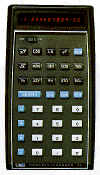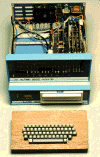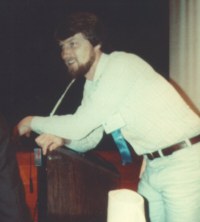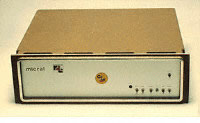click on the home button to go to the home page
|
The Industrial Era 1972 - 1973 The Third Generation computers started approximately in this era. These computers were mainly characterized by electronic models and were fully programmable. The first consumer game is published, diagramming techniques for software development were defined, the Hewlett Packard handheld scientific calculator HP35 is now available. |
pre history | antiquity |
pre industrial era | industrial
era
1947
- 1950 - 1952 - 1955
- 1958 - 1961 - 1963
- 1965 - 1969 - 1970
- 1972 - 1974 - 1976
- 1978 - 1980 -
1981 - 1982 - 1984 - 1986
- 1989 - 1991 - 1993
- 1994 - 1996 - 2000
- 2002
| Related Articles |
| Related Resources |
|
pre history |
![]() In January Magnavox (USA),
member of the North American Philips group, started selling a game computer
running "Odyssey". This game was already written in 1968(1)
for a mainframe computer by the American Ralph Baer. But as with most
advanced ideas it was too early for consumers, not ready at that time to adapt
something like a video game.
In January Magnavox (USA),
member of the North American Philips group, started selling a game computer
running "Odyssey". This game was already written in 1968(1)
for a mainframe computer by the American Ralph Baer. But as with most
advanced ideas it was too early for consumers, not ready at that time to adapt
something like a video game.
Commercially it meant a disaster and the 100 U$ game console gathered dust.

![]() On
24 August 1972 INTEL released the 200 kHz 8008, an 8 bit version of the 4004.
The speed was 300.000 instructions per second, could address 16Kb memory. It
contained 3500 transistors based on 10 micron technology. It was the first processor
able to recognize all characters of the alphabet (letters and numbers).
On
24 August 1972 INTEL released the 200 kHz 8008, an 8 bit version of the 4004.
The speed was 300.000 instructions per second, could address 16Kb memory. It
contained 3500 transistors based on 10 micron technology. It was the first processor
able to recognize all characters of the alphabet (letters and numbers).
The processor was originally built for Computer Terminal Corporation,- later
called Datapoint. This processor will instantaneously be popular with manufacturers
of small computers.

A so called "die" photo of the 8008 processor.
![]() As a result of the speed in development
of minituralization several pocket calculators appeared on the market. (Texas
Instruments brought out the types TI2500, 3000, 3500) but they were still very
expensive. All basic functions ( + - / : *) and a percentage key were present.
Numbers were displayed by a special kind of LED's, at the same time the reason
for high battery consumption. Rechargeable batteries only existed in laboratories
yet.
As a result of the speed in development
of minituralization several pocket calculators appeared on the market. (Texas
Instruments brought out the types TI2500, 3000, 3500) but they were still very
expensive. All basic functions ( + - / : *) and a percentage key were present.
Numbers were displayed by a special kind of LED's, at the same time the reason
for high battery consumption. Rechargeable batteries only existed in laboratories
yet.
![]() Hewlett Packard released the
first scientific calculator: the HP 35. This machine would wipe out the use
of what is left of slide rulers. The use of these ancient "calculators"
became extinct over night. This calculator had inherited many of the functionalities
of the HP 9100A model and it influenced the way mathematicians and engineers
would calculate. The HP35 contained 8 IC's and was sold at 395 U$. A lot of
money for that time.
Hewlett Packard released the
first scientific calculator: the HP 35. This machine would wipe out the use
of what is left of slide rulers. The use of these ancient "calculators"
became extinct over night. This calculator had inherited many of the functionalities
of the HP 9100A model and it influenced the way mathematicians and engineers
would calculate. The HP35 contained 8 IC's and was sold at 395 U$. A lot of
money for that time.
Hewlett Packard also wanted to make a move on the business market and brought out the HP 3000 minicomputer.

![]() In
November 29 1972, Nolan Bushnell(17)
and Al Alcorn wheeled a strange apparatus into Andy Capp’s Tavern in Sunnyvale,
Calif. Bushnell, the founder of a new company called Atari, and Alcorn, Atari’s
first engineer, set up the cube-like device on a barrel and switched it on.
Two dials were set below glowing rectangles on a screen. The instructions read:
“1. Insert quarter. 2. Ball will serve automatically. 3. Avoid missing
ball for high score.” Curious patrons began to follow step one.
In
November 29 1972, Nolan Bushnell(17)
and Al Alcorn wheeled a strange apparatus into Andy Capp’s Tavern in Sunnyvale,
Calif. Bushnell, the founder of a new company called Atari, and Alcorn, Atari’s
first engineer, set up the cube-like device on a barrel and switched it on.
Two dials were set below glowing rectangles on a screen. The instructions read:
“1. Insert quarter. 2. Ball will serve automatically. 3. Avoid missing
ball for high score.” Curious patrons began to follow step one.
Not before long, the machine stopped working. Alcorn returned to the bar to
check it out. Opening it up, he saw that the side-mounted coin mechanism (from
a Laundromat) was jammed—brimming with quarters. Pong was already on its
way to being the first commercially successful video game.
The game was called "Pong". A very simple contraption build from 2
knobs, logic modules and connectors for a TV. Pong was the first to combine
the critical elements: a simple interface, amusing play and technology that
was cheap and easy to manufacture. A decade after that first coin slot jammed,
arcades full of Pong progeny were bringing in $5 billion a year. The video-game
industry crash of the mid-1980s shook Atari and the rest of the gaming arena.
But by that time arcade games had introduced an entire generation to playful
computing.

The game looked like playing Ping Pong or "squash".
A cursor type of "ball" moved from left to right over the screen and
should be hit back by an electronic bat. This bat was controlled by turning
the knobs on the game console so the bat goes up or down to "hit"
the "ball" (cursor)
Look at the little point at the right hand side: the ball. The two little verticals
are the bats. The center line is the net and at the top "row" are
shown the points.
 To market their machine Bushnell and Alcom founded Atari.
To market their machine Bushnell and Alcom founded Atari.

![]() One
of the first digital microcomputers available for personal use in the USA was
the MITS (Micro Instrumentation and Telemetry Systems) 816. Though not equipped
with a display or keyboard, the 816 was of considerable interest to the amateur
enthusiast who wanted a personal computer. (31) It is also
the first computer to use the Intel 8008 CPU.
One
of the first digital microcomputers available for personal use in the USA was
the MITS (Micro Instrumentation and Telemetry Systems) 816. Though not equipped
with a display or keyboard, the 816 was of considerable interest to the amateur
enthusiast who wanted a personal computer. (31) It is also
the first computer to use the Intel 8008 CPU.

![]() ARPAnet
demonstrated at CS-ACM ICCC in Washington (31)
ARPAnet
demonstrated at CS-ACM ICCC in Washington (31)

![]() Xerox decided to
build a personal computer to be used for research. The project "Alto",
as it was called, started in November at the Palo Alto Research Center (PARC).
The result will be the Alto personal computer. But the machine did not sell
many copies because of its extreme high price. Nonetheless it served its research
purposes very well.
Xerox decided to
build a personal computer to be used for research. The project "Alto",
as it was called, started in November at the Palo Alto Research Center (PARC).
The result will be the Alto personal computer. But the machine did not sell
many copies because of its extreme high price. Nonetheless it served its research
purposes very well.
Also at PARC Gary Starkweather presented after 9 months of research the worlds first working laser printer. In 1973 there were several models of the laser printer at the center. And in 1977 Xerox will put the first commercial laser printer on the market, the Xerox 9700.(3) Ten years later HP will put the first personal laser printer on the market.
![]() A Canadian firm
Automatic Electronic Systems introduced the world's first programmable word
processor with a video screen" the AES 90. The system used magnetic disks
for storage and a custom built processor.(20)
A Canadian firm
Automatic Electronic Systems introduced the world's first programmable word
processor with a video screen" the AES 90. The system used magnetic disks
for storage and a custom built processor.(20)
![]() MAA (predecessor of Digital
Research) defined together with Intel a new system-programming language called
PL/M (Programming Language for Microcomputers)
to replace assembly-language programming for Intel's 8-bit processors .(16)
MAA (predecessor of Digital
Research) defined together with Intel a new system-programming language called
PL/M (Programming Language for Microcomputers)
to replace assembly-language programming for Intel's 8-bit processors .(16)
![]() The first implementation of
PROLOG (Programming in Logic)
was developed at University of Aix-Marselle. It will be the preferred language
for the 5th generation of machines. It's a descriptive and declarative language.(16)
The first implementation of
PROLOG (Programming in Logic)
was developed at University of Aix-Marselle. It will be the preferred language
for the 5th generation of machines. It's a descriptive and declarative language.(16)
![]() Dennis Ritchie from Bells Labs.
created C, a programming language
derived from BCLP. To become the most popular language for professionals, not
recommended for beginners.(16)
Dennis Ritchie from Bells Labs.
created C, a programming language
derived from BCLP. To become the most popular language for professionals, not
recommended for beginners.(16)
![]() FORTH
was developed, a medium-level language which used a small number of very brief
instruction words. Forth was originally designed for telescope control and it
would become the standard language used in astronomy.
FORTH
was developed, a medium-level language which used a small number of very brief
instruction words. Forth was originally designed for telescope control and it
would become the standard language used in astronomy.
![]() The first e-mail
program for Arpanet is created by Ray Tomlinson of BBN.(2)
The first e-mail
program for Arpanet is created by Ray Tomlinson of BBN.(2)
![]() Jonathan Titus from Blackburg,
Virginia (USA) developed the MARK-8 that was built on the basis of an Intel
8008(26) micro processor. However it
is a kit, something you had to build yourself. It had no power supply, monitor,
keyboard or housing to be bought separately. The publication in Radio Electronics
Magazine described however exactly how to built one.
Jonathan Titus from Blackburg,
Virginia (USA) developed the MARK-8 that was built on the basis of an Intel
8008(26) micro processor. However it
is a kit, something you had to build yourself. It had no power supply, monitor,
keyboard or housing to be bought separately. The publication in Radio Electronics
Magazine described however exactly how to built one.
The machine was programmed by setting eight (flip) switches, one for each bit.
One could imagine that programming the Mark 8 is still a time consuming business.
However since this computer was geared to the private market and only "computer
freaks" or hackers as they were often called did want to buy this computer.
The tedious way of programming did not matter. All what counted was that they
could do the programming in any way they liked. And the kick of having your
own computer was something you could not even start to explain.
Throughout the USA user groups were established and the computer newsletter
was a result thereof

![]() Gary Killdahl wrote a simple
operating system in his PL/M and he calls it CP/M (Control Program/Monitor
Gary Killdahl wrote a simple
operating system in his PL/M and he calls it CP/M (Control Program/Monitor
![]() UNIX was rewritten in 'C' and
became thus available for a large range of different machines.
UNIX was rewritten in 'C' and
became thus available for a large range of different machines.
UNIX became, because of its translation into "C", a very important
factor in the Operating System arena. About all computer networks were running
with Unix or a variant of it, or something that had the feel and working like
UNIX. Two of them are XENIX or Linux. Even micro computers ( ATARI,
Commodore Amiga) adapted a form of Unix for these OS's.
![]() Paul Fiedl a chemical
engineer at IBM develops SCAMP : the Special Computer APL
Machine Portable(18). When this machine
had interested John Opel (president of IBM) enough IBM would have had un contended
supremacy in Personal Computing. The SCAMP had a build in cassette tape drive,
a selectric type keyboard (standard keyboard for electric typing machines),
64k memory, and a very small screen. Fiedl even wrote a spreadsheet program
for financial modeling, a full three years before VisiCalc came out for the
Apple. But Opel thought it to be too complicated and too much ado about!
Paul Fiedl a chemical
engineer at IBM develops SCAMP : the Special Computer APL
Machine Portable(18). When this machine
had interested John Opel (president of IBM) enough IBM would have had un contended
supremacy in Personal Computing. The SCAMP had a build in cassette tape drive,
a selectric type keyboard (standard keyboard for electric typing machines),
64k memory, and a very small screen. Fiedl even wrote a spreadsheet program
for financial modeling, a full three years before VisiCalc came out for the
Apple. But Opel thought it to be too complicated and too much ado about!
![]() Again engineers of IBM came with
a new first and equips the newly released IBM
3740 with floppy drives that can read single sided 8" diskettes. The
floppies had twice the capacity of the previous one's of 1971: 250.000 characters.
Again engineers of IBM came with
a new first and equips the newly released IBM
3740 with floppy drives that can read single sided 8" diskettes. The
floppies had twice the capacity of the previous one's of 1971: 250.000 characters.
![]() Sharp (Japan)
developed the LCD (Liquid Crystal Display) technology which
was intended for amongst others calculators. Many years Sharp will stay market
leader in this field. The technology is going to evolve to large flat screens
for portable computers, but before that will happen another 20 years will pass.
Sharp (Japan)
developed the LCD (Liquid Crystal Display) technology which
was intended for amongst others calculators. Many years Sharp will stay market
leader in this field. The technology is going to evolve to large flat screens
for portable computers, but before that will happen another 20 years will pass.
|
The LCD technology This technology is build on the principle that crystals will be oriented in a particular direction when there is electrical current influencing them. It is like when a magnet it set close to a compass needle. The needle will than take a different direction. Because of the different orientation of the crystal in a particular LCD cell the screen in that part is no longer transparent. That is how pictures (and characters by the way) are represented or composed. |
![]() Twenty-seven years after the
unveiling of the ENIAC, and many years after the US Patent Office had issued
the patent for the computer to Eckert and Mauchly, the Judge Earl Larson of
the US District Court in Minneapolis invalidated it. In a suit between Honeywell
Information Systems and Sperry-Rand Corp. regarding the payment of royalties
for the use of the concept of the computer, Larson found that Mauchly had derived
his ideas for the computer from "one, John Vincent Atanasoff". Neither
Eckert nor Mauchly ever gave up their opposition to this finding, believing
that their invention was true. For many this was the first time they had heard
of the work of Atanasoff, or of the ABC.
Twenty-seven years after the
unveiling of the ENIAC, and many years after the US Patent Office had issued
the patent for the computer to Eckert and Mauchly, the Judge Earl Larson of
the US District Court in Minneapolis invalidated it. In a suit between Honeywell
Information Systems and Sperry-Rand Corp. regarding the payment of royalties
for the use of the concept of the computer, Larson found that Mauchly had derived
his ideas for the computer from "one, John Vincent Atanasoff". Neither
Eckert nor Mauchly ever gave up their opposition to this finding, believing
that their invention was true. For many this was the first time they had heard
of the work of Atanasoff, or of the ABC.
![]() Nassi and Schneider develop a
diagramming technique that produces "program structure diagrams" (PSD).
It enhances the analysis methodology for information systems enormously.
Nassi and Schneider develop a
diagramming technique that produces "program structure diagrams" (PSD).
It enhances the analysis methodology for information systems enormously.
A NSD diagram is a graphical representation of mostly a small part of the program
by means of a limited set of symbolic graphics. The picture you see below represents
a simple NSD diagram.
|
Nassi Scheider diagrams how you use them
|
![]() While the concept of a wide area
network has been effectively developed as a part of the ARPAnet project, the
basis for a "local area net" is Ethernet, created at Xerox PARC by
Robert Metcalfe. In some ways Metcalfe invents Ethernet three times, the first
time as part of his dissertation at MIT (as part of Project MAC), at Xerox PARC,
and then again later again at 3COM, a company he founds to exploit his invention.
While the concept of a wide area
network has been effectively developed as a part of the ARPAnet project, the
basis for a "local area net" is Ethernet, created at Xerox PARC by
Robert Metcalfe. In some ways Metcalfe invents Ethernet three times, the first
time as part of his dissertation at MIT (as part of Project MAC), at Xerox PARC,
and then again later again at 3COM, a company he founds to exploit his invention.
This protocol manages a Local Area Networks called LAN. And is a design that
allows computers to communicate to each other over a local area network.
![]() Internet consist of 25 computers.
Internet consist of 25 computers.
![]() Digital developed DEC Data Communication
Message Protocol (DDCMP) as a standard for its future computer-to-computer communications.
Digital developed DEC Data Communication
Message Protocol (DDCMP) as a standard for its future computer-to-computer communications.

![]() The
Bar code - Universal Product Code - is developed. This unique code consisted
of black stripes of two different thicknesses that could be read by special
bar scanners.
The
Bar code - Universal Product Code - is developed. This unique code consisted
of black stripes of two different thicknesses that could be read by special
bar scanners.
Almost all products in the world will have such a code, even magazines in the
next few years.
In shops cashiers and other point of sales ( POS19)
units will be equipped with barcode scanners in various forms, portable or built
in etc. Through this the price is always correct ( when the database in the
computer was correct at least). As a bonus the client will find much more information
on his sales slip than before.

![]() In France the first complete,
not as a do it yourself kit, micro computer was introduced: the Micral. The
design was based on the Intel 8008. But it will not be a commercial success.
Micrals most important contribution to the scene was that during a meeting about
the computer the term Micro Computer was coined.(20)
In France the first complete,
not as a do it yourself kit, micro computer was introduced: the Micral. The
design was based on the Intel 8008. But it will not be a commercial success.
Micrals most important contribution to the scene was that during a meeting about
the computer the term Micro Computer was coined.(20)
![]()
| Last Updated on October 21, 2004 | For suggestions please mail the editors |
Footnotes & References
| 1 | ref: correction by Ted Stahl |
| 2 | http://iml.jou.ufl.edu/carlson/1970s.shtml |
| 3 | http://www.crn.com/sections/special/hof/hof02.asp?ArticleID=38521 |
| 4 | ref http://www.yourdon.com/books/msa2e/CH15/CH15.html
last accessed 20 okt 2004 Nassi-Shneiderman diagrams (sometimes referred to as Chapin charts) were introduced in the 1970s (see [Nassi and Shneiderman, 1973] and [Chapin, 1974]) as a way of enforcing a strict structured programming approach. A typical Nassi-Shneiderman diagram is shown in Figure 15.3. As you can see, the diagram is easy to read. However, one could argue that Nassi-Shneiderman diagrams are just structured English statements with boxes drawn around them. |
| 16 | Marian Bozdoc, Auckland NZ, www.bozdoc.f2s.com (dead link) |
| 17 | Nolan Bushnell (Weyhrich 1991) |
| 18 | APL = A Programming Language |
| 19 | POS = Point of Sale; cashier or counter in a shop |
| 20 | Ken Olsson 1995, 2000 |
| 21 | MIPS = million instructions per second, long this standard will be used to indicate the speed of a processor. Until the speed of the processor produces unrealistic numbers; this plays begin 1990's. |
| 22 | Where to find what in the computer's memory; in other words on what location (read address) can a particular data or computer instruction be found |
| 23 | 1976 C.P.A./M TechKnowlogy 1992 |
| 24 | Automatiserings Gids 12/08/94 |
| 25 | BYTE September 1995 p 54 |
| 26 | 8080 CPU Weyhrich 1991 |
| 27 | Ken Olsson 1995 |
| 28 | H. Edward Roberts and William Yates, "Altair 8800 Minicomputer, Part 1", POPULAR ELECTRONICS, January 1975, pp. 33, 38. The article is interesting also in some of the terminology that is used. The Altair is described as having "256 eight-bit words" of RAM. Apparently, the term "byte" was not in common use yet. |
| 29 | Steven Levy, HACKERS: HEROES OF THE COMPUTER REVOLUTION, pp. 187-192. |
| 30 | Jack B. Rochester and John Gantz; The Naked PC; PCWorld p67-75, January 1988. Authors of The Naked Computer 1983 |
| 31 | www.computer.org; ACM = American Computer Organization |
| 32 | ATM automatic teller machine, you can now get money outside the bank office building and business hours |
| 33 | PIN = personal identification number |